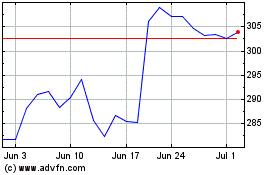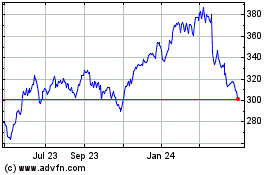New Accenture Research Finds Leaders and Employees Hold Differing Views on Progress Toward Equality
March 04 2020 - 12:01AM
Business Wire
Cutting the gap by half would boost global
profits by US$3.7 trillion, along with workforce ambition and
empowerment
A significant gap exists between the way leaders and employees
view progress toward equality in their organizations, according to
new research from Accenture (NYSE:ACN). Closing the gap will yield
substantial benefits for companies and their employees.
This press release features multimedia. View
the full release here:
https://www.businesswire.com/news/home/20200303005895/en/
(Graphic: Business Wire)
The report, “Getting to Equal 2020: The Hidden Value of Culture
Makers,” which includes research across 28 countries, found that
organizations are at an inflection point: Today’s workforce cares
increasingly about workplace culture and believes it is critical to
helping them thrive in the workplace (reported by 77% of women and
67% of men), and a majority of leaders (68%) believe an inclusive
workplace culture is vital to the success of their business.
At the same time, there is a perception gap: Two thirds of
leaders (68%) feel they create empowering environments where people
have a sense of belonging, yet just one third (36%) of employees
agree. Additionally, the proportion of employees who do not feel
included in their organizations is 10x higher than leaders believe
(20% vs 2%, respectively).
Most leaders also rank diversity and workplace culture low on
their list of top organizational priorities. Approximately
three-quarters of leaders ranked financial performance and brand
recognition and quality at the top of their list of priorities (76%
and 72%, respectively), while only 34% ranked diversity and 21%
ranked culture at the top.
“Creating a culture of equality must be at the top of the
business agenda. It starts with the belief that diversity is not
only the right thing to do, but a business imperative that is
treated the same as any other strategic priority,” said Julie
Sweet, CEO of Accenture. “When a strong, equal workplace culture is
prioritized, everyone benefits — and as a result, organizations
unlock greater innovation and growth.”
Narrow the gap, accelerate progress
Aligning leaders’ perceptions with those of their employees
would yield significant upsides. Everyone — both women and men —
would advance faster, and global profits would increase by US$3.7
trillion.
If the gap were closed by half:
- The proportion of women who feel like a key member of their
team with real influence over decisions would rise from 1-in-4 to
more than 1-in-3.
- The annual retention rate would increase by 5% for women and by
1% for men.
- The proportion of women who aim to reach a leadership position
in their organization would climb by 21%.
The research is especially timely for leaders, as employee
expectations are only set to increase: It found that a larger
percentage of Gen Z is more concerned with workplace culture than
Boomers (75% vs. 64%, respectively).
“Closing the perception gap starts with leaders understanding
there is a gap,” said Ellyn Shook, Accenture’s Chief Leadership and
Human Resources Officer. “It is an opportunity for leaders to
connect with and involve their people — to truly understand how
they feel at work. Based on what matters most to their people,
leaders can prioritize and take action to close the gap,
accelerating true equality for all in their organization.”
The Culture Makers
The report identified a small percentage of leaders — ‘Culture
Makers’ — who are more committed to building equal cultures. These
leaders recognize the importance of factors such as pay
transparency, family leave and the freedom to be creative in
helping employees thrive.
Culture Makers are much more likely to have spoken out on a
range of workplace issues, including gender equality (52% vs. 35%
of all leaders) and sexual harassment/discrimination (51% vs. 30%).
They hold themselves accountable, leading organizations that are
nearly twice as likely to have publicly announced a target to hire
and retain more women.
While just 6% of leaders surveyed are Culture Makers, they
represent a more gender-balanced group compared to the broader
group of leaders surveyed (45% women vs 32% of all leaders,
respectively). Additionally, a full 68% of them are Millennials,
compared to 59% of all leaders. They are more likely to lead
organizations where people advance, focus on innovation and remain
committed — and their organizations’ profits are nearly three times
higher than those of their peers.
Achieving a culture of equality
The report lays out steps to help close perception gaps and
drive progress toward a more equal culture that benefits everyone
and enables leaders to continuously evolve their strategies to meet
changing needs.
The research reaffirms that bold leadership, comprehensive
action and an empowering environment are proven anchors for
creating a culture of equality:
- Bold Leadership – Leaders must truly believe that culture
matters and prioritize it. For example, benchmark progress
toward a culture of equality by setting and publishing targets; and
reward and recognize leaders and teams on progress. A culture of
equality starts at the top.
- Comprehensive Action – Go beyond the data. Leaders
should engage in a meaningful, continuous dialogue with employees.
Consider face-to-face meetings, focus groups, town halls.
Conducting ongoing, real-time conversations with employees helps to
capture feedback and empower leadership to quickly drive
change.
- Empowering Environment – Encourage and cultivate Culture
Makers. Create opportunities for future Culture Makers to
opt-in and take on specific culture-related roles within their
organizations and find ways to bring leaders and culture-minded
employees together to develop specific, actionable solutions.
Read the global report at: accenture.com/gettingtoequal
Methodology
Building on previous Accenture research that has explored how to
build a workplace culture of equality and the benefits for
organizations and employees, the report is based on a global survey
of more than 30,000 professionals in 28 countries; a survey of more
than 1,700 senior executives; and a model that combines employee
survey results with published labor force data. Accenture leveraged
it’s Getting to Equal research from 2018 and 2019 to create new
data and analysis using three steps: quantifying the perception
gap, measuring the impact of the perception gap on employee
outcomes, and measuring the impact of closing the perception
gap.
About Accenture
Accenture is a leading global professional services company,
providing a broad range of services in strategy and consulting,
interactive, technology and operations, with digital capabilities
across all of these services. We combine unmatched experience and
specialized capabilities across more than 40 industries — powered
by the world’s largest network of Advanced Technology and
Intelligent Operations centers. With 505,000 people serving clients
in more than 120 countries, Accenture brings continuous innovation
to help clients improve their performance and create lasting value
across their enterprises. Visit us at www.accenture.com.
View source
version on businesswire.com: https://www.businesswire.com/news/home/20200303005895/en/
John Connolly Accenture +1 917 452 0837
john.a.connolly@accenture.com
Sam Hyland Accenture +1 917 452 5184
samuel.hyland@accenture.com
Accenture (NYSE:ACN)
Historical Stock Chart
From Mar 2024 to Apr 2024

Accenture (NYSE:ACN)
Historical Stock Chart
From Apr 2023 to Apr 2024
